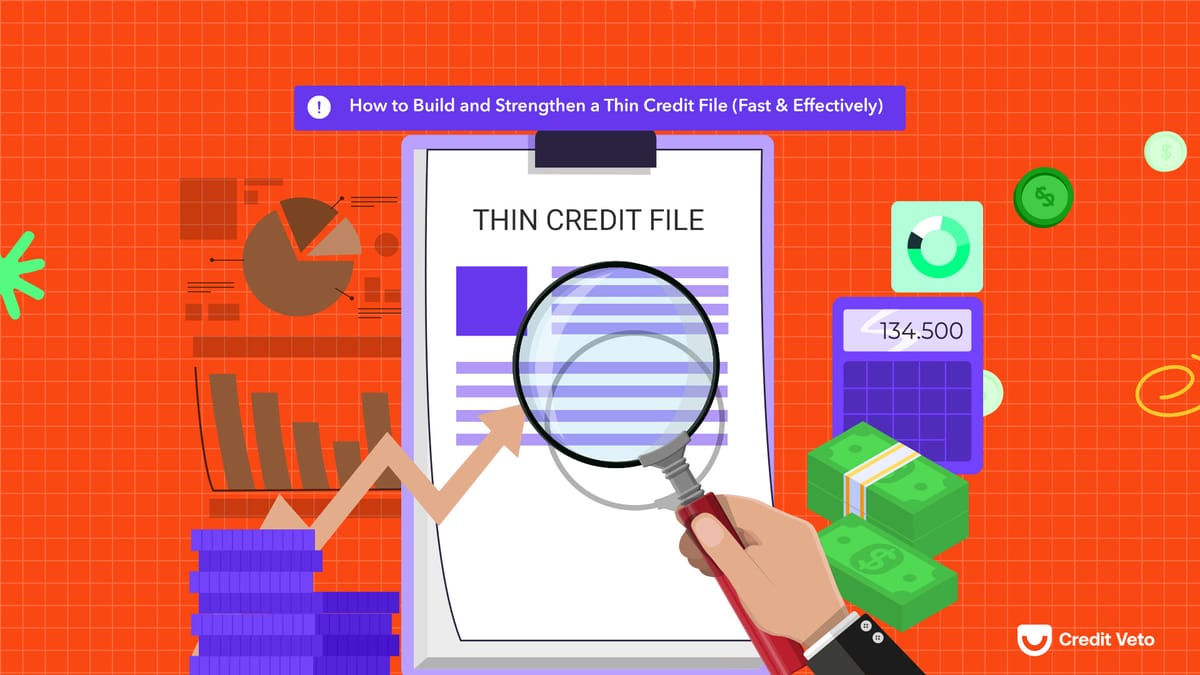How to Build and Strengthen a Thin Credit File (Fast and Effectively)
Struggling with a thin credit file? Learn fast and proven ways to build credit with secured cards, credit monitoring, and smart financial habits. Start improving your credit today!

Having limited credit experience or a thin credit file can make it difficult to qualify for loans, credit cards, rental agreements, or even buying your dream home.
You're not alone if you’ve ever been told you have insufficient credit experience or that your credit report is too thin. According to the Consumer Financial Protection Bureau (CFPB), nearly 26 million Americans are "credit invisible," meaning they have no credit history, while another 19 million have a thin credit report, meaning their history is too limited for a credit score.
The good news? There are proven strategies to build and strengthen a thin credit file fast—even if you’re starting from scratch.
What Does A Thin or Limited Credit Mean?
If you have thin or limited credit, it means you don’t have enough credit history for lenders to evaluate your financial reliability.
Having limited credit or being a thin filer shows your credit report does not contain enough credit accounts for credit bureaus to generate a reliable credit score. This situation typically affects:
- Young adults who have never used credit before.
- People who use only cash or debit cards and avoid borrowing money.
- Immigrants who have recently moved to the U.S. and have no credit history in the country.
- Individuals who haven't used credit for a long time, causing their previous accounts to be removed from their credit report.
Signs That You Have a Thin Credit File
If you’re unsure whether you have a thin credit report, here are a few ways to find out:
- You don’t have a FICO or VantageScore (or your score is labeled as “Insufficient Credit”
- You’ve been denied credit cards or loans due to "Limited Credit Experience"
- Your credit report only contains 1 or 2 accounts
- You have little or no credit history in the past 24 months
Note: A thin credit file doesn’t mean you have bad credit—it just means you need to start building credit history so lenders can evaluate your financial responsibility.
How to Build and Strengthen a Thin Credit File (Fast & Effectively)
If you're wondering how to establish credit from scratch, follow these proven strategies:
1. Enroll in a Credit Monitoring Service
One of the most important steps in building your credit is tracking your progress. Many people with thin credit files don’t realize that monitoring their credit report is a must when it comes to preventing errors, detecting identity theft, and providing insights into how to improve their credit profile.
Why Credit Monitoring is Crucial:
- Alerts you of new accounts and inquiries on your credit report.
- Helps identify errors or fraudulent activity early.
- Allows you to track your score improvement over time.
- Gives personalized recommendations on how to improve your credit.
Credit Veto offers credit monitoring services that help individuals with limited credit experience gain better financial awareness while building their credit.
2. Open a Secured Credit Card

If you don’t have any credit history, getting approved for a regular credit card might be tough. A secured credit card is one of the best ways to start building credit because it requires a refundable security deposit—which becomes your credit limit.
Studies show that over 50% of people with thin credit files see a credit score increase of 50-100 points within 6 months of using a secured card responsibly.
Pro-Tip: Choose a secured credit card that reports to all three credit bureaus (Experian, Equifax, TransUnion) so your payment activity builds your credit history.
3. Become an Authorized User on Someone Else’s Credit Card
One of the fastest ways to establish a credit history is by becoming an authorized user on a family member’s or friend’s credit card. When added as an authorized user, their positive payment history will be reflected on your credit report.
Choose a cardholder with a long history of on-time payments and a low credit utilization ratio. Make sure the credit card issuer reports authorized users to credit bureaus, as not all do.
4. Apply for a Credit-Builder Loan
A credit-builder loan is specifically designed to help people with no credit history. Instead of receiving money upfront, your payments are held in a savings account until the loan is fully paid off—and every on-time payment is reported to the credit bureaus.
According to a study by the Consumer Financial Protection Bureau (CFPB), credit-builder loans helped 75% of thin-file consumers increase their credit score within 12 months.
Where to Get One? Local credit unions, online lenders, and community banks often offer these loans.
5. Use Experian Boost to Report Non-Traditional Payments
If you don’t have credit cards or loans, you can still build credit by using Experian Boost—a free tool that allows you to add rent, utility, and phone bill payments to your credit report.
- Experian Boost can help increase credit scores by an average of 13 points for people with thin credit files.
- It only takes a few minutes to set up, and the benefits show up immediately on your credit report.
6. Keep Credit Utilization Low & Pay Bills On Time
Once you’ve opened a credit account, maintaining a low credit utilization ratio is key.
Rule of Thumb: Keep your credit card balance below 30% of your credit limit.
People who keep their credit utilization below 10% tend to have higher credit scores than those who max out their cards.
Additionally, make on-time payments every month—even one late payment can drop your score by 50-100 points.
How Long Does It Take to Build Credit from a Thin File?
While credit-building strategies work fast, it takes time to establish a strong credit history. According to FICO, it typically takes 3-6 months to generate a credit score from a thin credit file.
Credit Score Milestones for Thin Filers:
- 1-3 months: Initial credit score appears
- 6 months: Score improvement begins
- 12+ months: More credit opportunities open up
Take Action & Start Building Credit Today
If you have a thin credit file, you’re not alone—but the sooner you take action, the faster you’ll build a strong credit history.
Key Takeaways:
- Get a secured credit card or a credit-builder loan
- Become an authorized user on a well-managed account
- Use Experian Boost to report rent and utility payments
- Keep credit utilization low and pay bills on time
- Use credit monitoring services to keep track of your progress
Need help improving your credit file? Contact Credit Veto today and get expert guidance and AI powered system on building your credit profile the right way!




Comments ()